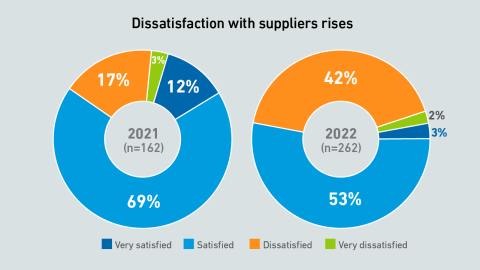The data center industry's largest and most influential survey results are in! Join us as we discuss the 13th Annual Uptime Global Data Center Survey 2023 which reveals an industry that is growing, dynamic and increasingly resilient.
filters
Explore All Topics
Uptime Intelligence has been providing regular updates and insights on the efforts of the European Parliament and European Commission (EC) to finalize the Energy Efficiency Directive (EED) recast requirements. The directive is the most radical and…
75% of organizations in North America have experienced supply chain delays. With organizations already stretching equipment life-cycles, how do we stay ahead of equipment and spare shortages that could leave us vulnerable?
The public cloud’s on-demand pricing model is vital in enabling application scalability — the key benefit of cloud computing. Resources need to be readily available for a cloud application to scale when required without the customer having to give…
Operators report that their sustainability initiatives not only benefit the environment - they also reduce operating costs and improve customer engagement. Sustainability strategies, however, vary widely.
There is evidence that outage rates have been gradually falling in recent years. This report brings together and analyzes recent Uptime Institute data on IT and data center outage trends: their causes, costs and consequences.
Hyperscale cloud providers have opened numerous operating regions in all corners of the world over the past decade. The three most prominent — Amazon Web Services (AWS), Google Cloud and Microsoft Azure — now have 105 distinct regions (excluding…
Uptime Intelligence finds that operators and vendors face major delays in the supply of equipment, and are increasingly dissatisfied with their suppliers.
The past decade has seen numerous reports of so-called cloud “repatriations” — the migration of applications back to on-premises venues following negative experiences with, or unsuccessful migrations to, the public cloud.A recent Uptime Update (High…
Big public-cloud operators have often had to compete against each other — sometimes ferociously. Only rarely have they had to compete against alternative platforms for corporate IT, however. More often than not, chief information officers (CIOs)…
Up until two years ago, the cost of building and operating data centers had been falling reasonably steeply. While labor costs have risen during this time, better management, processes and automation have helped to prevent spiraling wage bills.
A host of regulations worldwide have introduced (or will introduce) legal mandates forcing data center operators to report specific operational data and metrics. Key examples include the European Union’s Corporate Sustainability Reporting Directive …
Unexpected costs are driving some data-heavy and legacy applications back from public-cloud to on-premises locations. However, very few organizations are moving away from the public cloud strategically — let alone altogether.The past decade has seen…
European Union (EU) regulators wrapped up 2022 with new legislation introducing stricter requirements for data center operators. Four major regulations were passed (with strong majorities) in the European Parliament — most of these having been…
The European Commission (EC) has published a draft technical document on data center metrics and reporting obligations in support of the deployment of its Energy Efficiency Directive (EED) recast. The Directive is intended to encourage operators to…
 Andy Lawrence
Andy Lawrence
 Daniel Bizo
Daniel Bizo
 Chris Brown
Chris Brown
 Jacqueline Davis
Jacqueline Davis

 Jay Dietrich
Jay Dietrich

 Matt Stansberry
Matt Stansberry

 Dr. Owen Rogers
Dr. Owen Rogers

 Douglas Donnellan
Douglas Donnellan

 Lenny Simon
Lenny Simon





 Max Smolaks
Max Smolaks